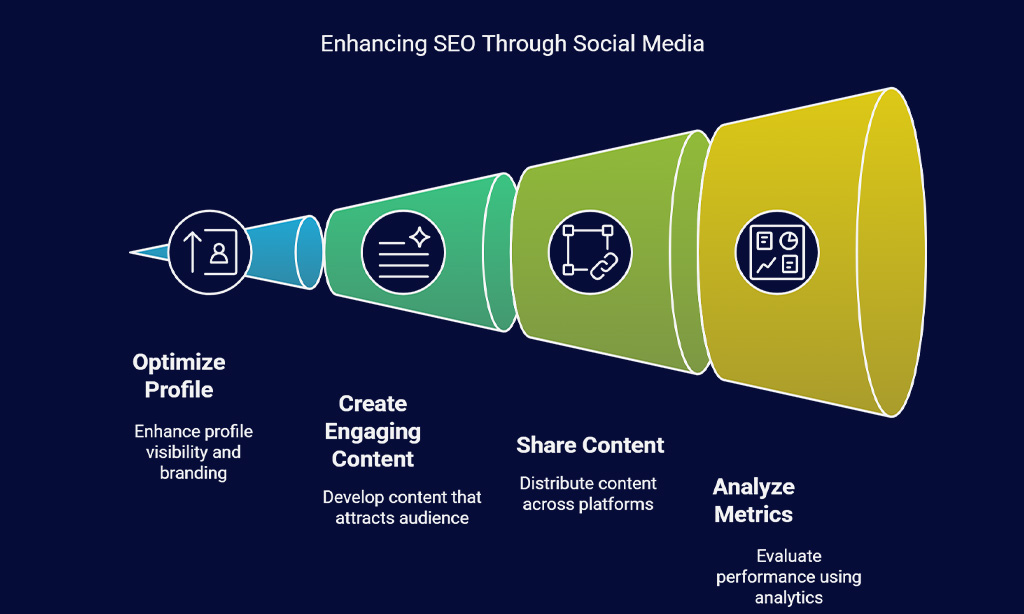Do you feel lost when people search for your name online? It can feel like shouting into an empty room, and that gets old fast. Many experts share great ideas, yet they miss the crowd.
This gap hurts your personal brand and hides your thought leadership.
Here is a fact. SEO is part of organic online marketing, not a paid ad tool. This blog will help you Utilize SEO For Personal Branding. You will learn to build a personal website and use keyword research.
You will craft fresh content, leverage social media signals, and track progress with analytics tools and webmaster tools. This plan will boost your search engine rankings and sharpen your brand identity.
Read on.
Key Takeaways
- Build a personal site on WordPress with a catchy domain. Optimize title tags, meta descriptions, and schema markup. Match your photo, name, and bio on LinkedIn and Twitter to boost brand recognition.
- Use keyword research to guide every post. Poll your LinkedIn or Twitter audience, then use SEMrush, AHrefs, and Google Search Console to find and track terms—remember Google sees 3.5 billion searches per day.
- Create niche blog posts with schema markup and weave in target phrases. Repurpose each post into a 60‑second video, an infographic, a mini‑course, or tweet series to drive engagement.
- Leverage social signals on LinkedIn and Twitter. Add hashtags, optimized headlines, fresh banners, and links to your site. Track clicks and shares in Google Analytics, Search Console, and Bing Webmaster Tools to lift your SEO.
- Monitor and tweak with analytics tools. Use Google Analytics for traffic, Search Console for ranking shifts and HTML errors, and Bing Webmaster Tools for crawl reports. Review metrics weekly and update title tags, meta lines, sitemap, and page speed.
Build a Personal Website
Pick a catchy domain, and install WordPress to show off your work. Sprinkle title tags, meta descriptions, and schema markup so Google Search Console, and Google Analytics can share traffic insights.
Optimize your bio and about page for SEO
Set your title tag to rank #1 for your name. Add target keywords like content strategy or thought leadership in the meta description. Use schema markup on your bio page as microdata.
That helps Google parse your name, photo, and value proposition. Track index stats in Google Search Console. Monitor visitor counts in Google Analytics.
Match your photo, name, and bio on your website, LinkedIn, and Twitter. That uniform profile boosts brand recognition. Include your key skills in alt tags on your photo. Link each social bio back to your main site.
That link building lifts your search engine results.
Use schema markup to enhance visibility
Your bio page can speak to search engines with schema markup. JSON-LD tags give bots details on your name, role, skills and links. Structured data lets crawlers see your work, social profiles and articles.
You might see rich snippets like ratings or event dates show up under your site link. This extra info can lift your spot on search engine results pages.
Google Search Console tests your markup under the Enhancements report. Use SEO tools like Yoast or Google Tag Manager to add and verify code. This step builds online visibility, and supports your personal branding.
Smart structure on a personal website feeds crawlers, and grows thought leadership.
Conduct Keyword Research
Find the search terms your target audience types, then track their performance in Search Console. Good keyword research steers your content strategy like a compass on a map.
Identify keywords related to your expertise
Google handles 3.5 billion searches per day. Smart keywords push your profile in search results.
- Poll your target audience on LinkedIn or Twitter to note real questions they ask on social media platforms.
- Use SEMrush for keyword research to find monthly search volume and competition scores.
- Pull data from Google Search Console to spot terms your site ranks for and refine them.
- Tap AHrefs to gather related phrases and spot gaps in your blog posts.
- Pair each phrase with your thought leadership theme to boost personal branding and online presence.
- Rank terms by user intent to refine your content strategy and grow quality traffic.
Integrate keywords into your content naturally
Experts craft headings with priority terms from keyword research. Writers place search terms in title tags, in the first paragraph, and in alt text for images. They weave phrases into meta descriptions and headers to boost online presence.
A smart content strategy uses long‐tail queries, near matches, and natural flow. It treats keywords like spices, added just enough.
An analytics tool tracks which phrases bring traffic. A seo analytics tool shows ranking changes. A search console flags thin content or keyword stuffing. It highlights low click‐through rates and poor user experience.
You swap stale terms for fresh content, you refine personal branding, you follow seo best practices.
Create Valuable Content
Write articles that spark thought leadership and real audience engagement. Then peek at Google Analytics and Search Console to see which topics shine.
Write blogs focused on your niche
Pick a narrow specialty and write posts that fit that scope. Share deep insight on personal branding or influencer marketing topics. Sprinkle in keywords like keyword research, content creation, technical seo.
Target title tags and meta descriptions for each post. Link to older articles to drive site traffic and improve online presence. Mark up your posts with schema to help search engines find your work.
Add a dash of wit or an anecdote to keep readers hooked.
Share each new post on LinkedIn and Twitter to drive audience engagement. Track visits with an analytics tool and check kpis often. Rewrite headlines when click-through dips. Experiment with infographics or YouTube videos to spice up fresh content.
Boost social media optimization by adding descriptive alt text and hashtags.
Repurpose content for multiple platforms
You can turn one blog into many assets. It grows your online presence.
- Turn a blog post into a 60‑second video clip for a video site. Add captions and brand logo to boost engagement and online visibility on search engine result pages.
- Use a design tool to craft an infographic from your top tips. Share it on LinkedIn and your site to strengthen personal branding.
- Build a mini‑course on a course platform using your blog outline. Link it in your bio and track sign ups with Google Analytics for content strategy insights.
- Slice a blog into bite‑size tweets on Twitter to spark conversations. Tag influencers and include trending hashtags to grow audience engagement.
- Embed an infographic and a video on your website using schema markup. This step boosts link building and draws more visits from Google Search Console data.
Leverage Social Media for SEO
Sprinkle hashtags on a professional network or a microblogging site to spark social signals and fuel your search rankings. Then check Google Analytics and Google Search Console to see which updates pull in the most clicks.
Share optimized content on LinkedIn and Twitter
You need to stand out on social platforms. Smart posts boost your SEO.
- Add a fresh banner image on LinkedIn to boost your profile view. You raise your online visibility and support your personal branding.
- Tweak your public profile URL to mirror your name or niche. That move can aid in keyword research for search engine optimization.
- Write punchy headlines that contain key terms like thought leadership or content strategy. You draw your target audience to your bio.
- Include relevant hashtags and links in every tweet and post. You send strong signals to Google Search Console and Google Analytics for better indexing.
- Share blog posts and articles that use title tags and meta descriptions. You attract click-throughs and drive website traffic.
- Review post metrics in Google Analytics and Twitter Analytics weekly. You track audience engagement and refine your content strategy.
Use social media signals to boost search rankings
Promote blog posts on a professional platform and microblogging site to spark social signals, boost SEO, and expand your online presence. A surge of shares, comments, and likes sends data to Google Search Console and propels pages up search results.
Content strategy and audience engagement merge in this tactic.
Leverage community feedback as referral traffic fuel and turn followers into link building allies. Craft title tags and meta descriptions, and track key performance indicators [KPIs] in Google Analytics to sharpen thought leadership and drive personal branding.
Monitor and Analyze SEO Performance
Be a detective with your analytics suite, it flags secret traffic slips, and leads you to click treasure. Then pop into your site dashboard, track rankings and engagement metrics, and tweak tactics on the fly.
Use SEO tools to track rankings and traffic
Data fuels your online presence. Analytics guide content strategy and SEO decisions.
- Google Analytics tracks traffic, session time, and click through data for your personal branding site.
- Google Search Console reveals ranking shifts, html tag errors, and meta description issues that hurt your online reputation.
- Bing Webmaster Tools shares impression counts, privacy settings alerts, and crawl reports that boost online visibility and search engine marketing.
- SEO analytics tools let you merge data to spot fresh content winners and link building gaps.
Adjust strategies based on performance metrics
Tracking metrics keeps your personal brand sharp. It reveals weak spots in your content strategy.
- Check traffic sources with a site analytics tool to spot your top pages. Tweak title tags based on high-value keywords to lift online presence.
- Compare backlink growth in your search console reports. Adjust link building moves to match your target audience’s interests.
- Review bounce rates on blog posts that cover thought leadership. Rewrite meta descriptions to drive clicks and reduce exits.
- Track keyword rankings for your niche terms each week. Update content strategy with fresh content and relevant tags.
- Update technical SEO settings in your XML sitemap and schema markup. Improve page speed and mobile scores to engage more visitors.
- Invest in ongoing education through webinars on seo best practices. Apply new techniques from seo analytics tools to sharpen your skills.
Takeaways
Make your brand fly high in search, like a bright kite. Set up a sleek personal site. Tweak title tags and meta lines. Find phrases that match your skills. Tag pages in Google Search Console.
Use a keyword tracker. Share posts on LinkedIn, Twitter, or other feeds. Update fresh content each week. Team up with peers to grow your online reputation. This plan lifts your online visibility, and draws in your target audience.
FAQs on Ways To Utilize SEO For Personal Branding
1. What is SEO for personal branding?
SEO, or search engine optimization, helps people find you on the web. It boosts your online presence, lifts your visibility, and shapes your thought leadership.
2. How do you pick the best keywords?
Keywords act like signposts that guide readers back to you. Do keyword research, check data in the search console and scholar search, and focus on terms your target audience types.
3. How do you make high-quality content?
Good content starts with a plan, a solid content strategy, and fresh content, like articles on your personal website. Think of your page like a well-organized closet, where title tags and html tags each have their own shelf. This helps search engines pick your best work.
4. How do you build links and manage your reputation?
Link building is like making friends at a party: the more sites that link to you, the stronger your brand. Be active on online platforms, join discussions, and guard your online reputation management by fixing errors fast and answering questions with empathy.
5. How do you track your SEO success?
Use site analytics tools, like google analytics, and check the search console often. SEO analytics tools give data on clicks, views, bounce rates, and more. This lets you tune your content creation and boost audience engagement.






































